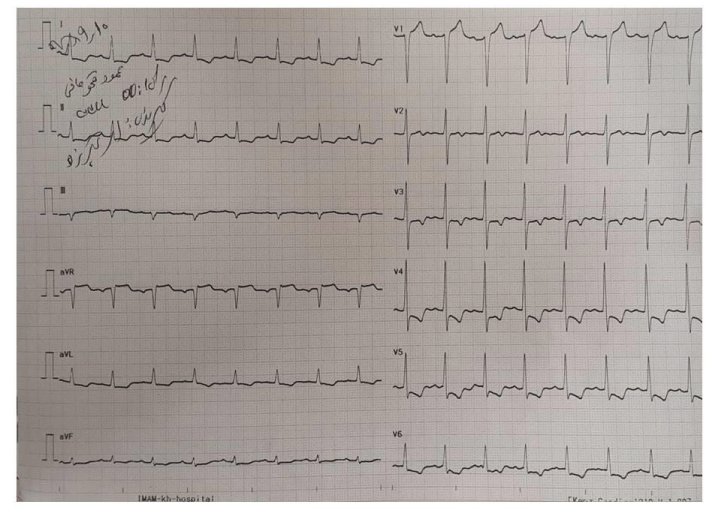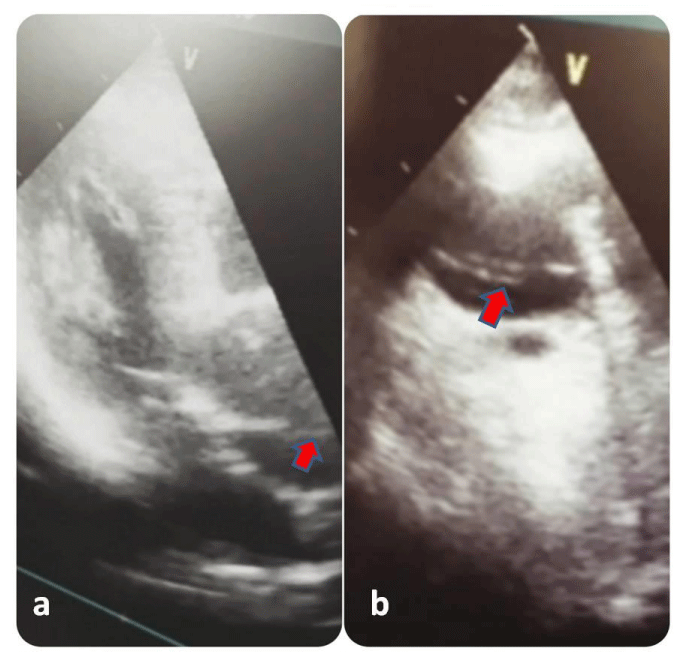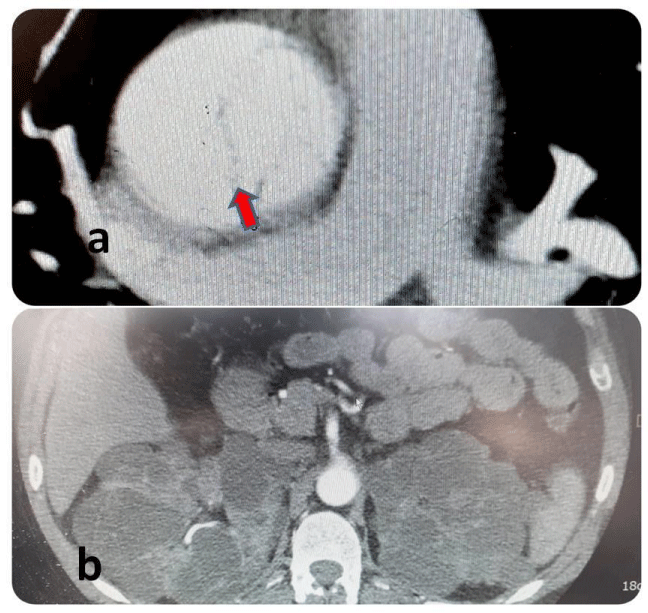Spontaneous Aortic Dissection Type A as the First Manifestation of Autosomal Dominant Polycystic Kidney Disease: A Case Report?
Hamid Khederlou1 and Yaser Jenab2*
1Tehran Heart Center, Tehran University of Medical Sciences, Tehran, Iran
2Fellowship of Interventional Cardiology, Tehran Heart Center, North Kargar Street, Tehran, Iran
*Address for Correspondence: Yaser Jenab, Fellowship of Interventional Cardiology, Tehran Heart Center, North Kargar Street, Tehran, Iran. ORCiD: 0000-0002-8291-8637; E-mail: yasjenab@gmail.com
Submitted: 08 March 2021; Approved: 15 March 2021; Published: 16 March 2021
Citation this article: Khederlou H, Jenab Y. Spontaneous Aortic Dissection Type A as the First Manifestation of Autosomal Dominant Polycystic Kidney Disease: A Case Report. Int J Case Rep Short Rev, 2021 March 16; 7(1): 005-000. doi: 10.37871/ijcrsr.id94
Copyright: © 2021 Khederlou H, et al. This is an open access article distributed under the Creative Commons Attribution License, which permits unrestricted use, distribution, and reproduction in any medium, provided the original work is properly cited
Keywords: Autosomal dominant polycystic kidney disease; Cardiovascular involvement; Aortic dissection
Download Fulltext PDF
Autosomal Dominant Polycystic Kidney Disease (ADPKD) is one of the genetic diseases and is characterized by progressive, multiple and bilateral renal cysts overtaking to massive enlargement of the kidneys and eventually renal failure. Thoracic aortic dissection is rare complication of ADPKD that usually occurs after a time interval of 8 years from diagnosis of ADPKD. Hereby we reported a 34 year old man with acute aortic dissection type A with ADPKD who his ADPKD has not been diagnosed until now, and aortic dissection was the first manifestation of ADPKD.
Introduction
Autosomal Dominant Polycystic Kidney Disease (ADPKD) is one of the genetic diseases with two genes caused by mutations in polycystic kidney disease-1 (PKD-1) or PKD-2 gene [1]. ADPKD seen 1 in 1000 individuals and is describe by progressive, multiple and bilateral renal cysts leading to massive enlargement of the kidneys and finally renal failure. Although renal cysts and renal failure are the cardinal and main manifestations of ADPKD, but; extra renal manifestations such as liver and pancreas cysts, colon diverticula, and involvement of cardiovascular and central nervous system are well identified in ADPKD [2].
Cardiovascular involvement including early onset hypertension, Left Ventricular Hypertrophy (LVH), cardiac valvular abnormalities such as mitral valve prolapse, aortic root and annulus dilation, cerebral and coronary aneurysm [3]. Also, very few cases of thoracic aortic dissections related to ADPKD have been reported [4]. There are two types of aortic dissection; type A and type B. type A, if the aortic dissection occurs in the ascending aorta and type B, if aortic dissection originates in the descending aorta [5].
We hereby report a case of type A acute aortic dissection in a patient with ADPKD who his ADPKD has not been diagnosed until his presentation.
Case Presentation
History and physical findings
A 34 year old male patient, without any past medical history and medication was admitted with chest pain as retrosternal, pressure like, squeezing and radiates on the midline between the scapulas. He also complained of dizziness, general weakness, diaphoresis and nausea. On examination at first hospitalization, his blood pressure was 168/84 mmHg in the left arm and 128/68 mmHg in the right arm, also; his heart rate and body temperature were 106 beat/Min and 37.1°C, respectively. The pulse of the hands was asymmetrical; so that the pulse of the right hand was felt weaker. He was pale and somewhat somnolent. Diastolic decrescendo murmurs with grade 3/6, which heard in the right parasternal region, were noted.
Electrocardiogram (ECG)
The Electrocardiogram (ECG) changes at admission revealed sinus tachycardia and coronary ischemia with involvement of the left main artery in the form of generalized ST segment depression in all leads except in leads V1 and VR, which showed a ST-segment elevation (Figure 1).
Echocardiography
Echocardiography showing the dissection over the level of the aortic valve, above the origin of the coronary arteries in the form of dilatation and intimal flap in the ascending aorta and aortic arch (Figure 2).
Imaging
Thoracoabdominal Computed Tomography Angiography (CTA) was done urgently. Thoracic view of CTA showed an intimal flap, double-lumen and dilatation of the ascending aorta; Also, abdominal view of CTA revealed multiple cysts in bilateral renal and liver (Figure 3).
Discussion
Genetics
Although we did not determine the genetic analysis in this study, but; mutations in PKD1 are responsible for 85% of cases in clinically identified populations. PKD1 and PKD2 gene are expressed in the smooth muscle cells and endothelial cells of the blood vessel. PKD1 encodes polycystin-1 and a large integral membrane protein. PKD2 encodes polycystin-2 and a transient receptor potential calcium ion channel [6,7]. Mutations of these proteins or calcium ion channel cause to development, polarization, and environmental sensation of cells that through effects on the primary cilia leading to entails the development of fluid-filled cysts in target organs [2,8].
Pathophysiology
Recently, it has been demonstrated that impairment of polycystin 1 or 2 in the cilia, endothelial cells, and vascular smooth muscle cells is associated with abnormal vascular structure and function. Endothelial cilia sense fluid shear stress by polycystin 1 and 2; and this function associated to complex biochemical cascade involving many factors, including nitric oxide. Indeed, Pkd1/Pkd2 deficiency alters the endothelial response to shear stress through reduces nitric oxide levels [9]. Overally, hardly any histopathologic analyses on dissections and aneurysms in ADPKD have been performed [7].
Epidemiological aspects
ADPKD is the most common inherited renal disorder that is seen 1 in 400-1000 live births [2]. Thoracic aortic dissection is rare complication of ADPKD, but; this complication is 8 times more common in patients with ADPKD than in the general population [10]. Similar to our case, people with ADPKD usually develop aortic dissection at an earlier age [4].
Manifestation
Progressive, multiple and bilateral renal cysts overtaking to massive enlargement of the kidneys and eventually renal failure is the cardinal manifestations of ADPKD. Except the liver, cysts showed in the pancreas, spleen, seminal vesicles, ovary and arachnoid [11]. In our case, cysts are also seen in the kidneys and liver.
Hypertension is common complication of extra renal in ADPKD that occur in approximately 80% and this complication observed even before renal dysfunction [4]. Like our case in this study, LVH is also one of cardiac complication of ADPKD that occur secondary to hypertension and nearly 50% of hypertensive ADPKD patients exhibit left ventricular hypertrophy. LVH leading to progressive cardiac dysfunction and increased morbidity and mortality [12]. Valvular abnormalities, aortic and coronary aneurysm, tamponade, and aortic dissection are less common cardiac complications of polycystic kidney disease 3 that prevalence of these manifestations is fairly consistent between various studies [13]. According to studies, aortic dissection usually occurs after a time interval of 8 years from diagnosis of polycystic kidney disease [4]. While hypertension and ADPKD of our cases in this study was not previously diagnosed, and aortic dissection was the first manifestation of ADPKD.
Asymptomatic intra/extracranial aneurysms, colonic diverticula, abdominal hernia, bronchiectasis, male infertility, pain are other manifestation of ADPKD [11].
Prognosis and mortality
Mortality in ADPKD patients is Up to three times higher than the general population [14]; and cardiovascular complications such as aortic dissection are the most common cause of death in ADPKD [15]. As we saw in our case, these complications even may be present before apparent renal dysfunction [16].
- Aoyagi S, Oda T, Kanamoto R, Nakamura E, Yasunaga H. Aortic Dissection Associated with Autosomal Dominant Polycystic Kidney Disease: A Case Report. 2019 ;22:32-4.
- Torres VE, Harris PC, Pirson Y. Autosomal dominant polycystic kidney disease. Lancet. 2007;369:1287-301.doi: 10.1016/S0140-6736(07)60601-1
- Luciano RL, Dahl NK. Extra-renal manifestations of autosomal dominant polycystic kidney disease (ADPKD): considerations for routine screening and management. Nephrology Dialysis Transplantation. 2014;29:247-54. doi: 10.1093/ndt/gft437
- Sung PH, Yang YH, Chiang HJ, Chiang JY, Chen CJ, Liu CT, Yu CM, Yip HK. Risk of aortic aneurysm and dissection in patients with autosomal-dominant polycystic kidney disease: a nationwide population-based cohort study. Oncotarget. 2017 Mar 17;8(34):57594-57604. doi: 10.18632/oncotarget.16338. PMID: 28915698; PMCID: PMC5593670.
- Macura KJ, Corl FM, Fishman EK, Bluemke DA. Pathogenesis in acute aortic syndromes: aortic dissection, intramural hematoma, and penetrating atherosclerotic aortic ulcer. AJR Am J Roentgenol. 2003 Aug;181(2):309-16. doi: 10.2214/ajr.181.2.1810309. PMID: 12876003.
- Drummond IA. Polycystins, focal adhesions and extracellular matrix interactions. Biochim Biophys Acta. 2011 Oct;1812(10):1322-6. doi: 10.1016/j.bbadis.2011.03.003. Epub 2011 Mar 9. PMID: 21396443; PMCID: PMC3132319.
- Hassane S, Claij N, Lantinga-van Leeuwen IS, Van Munsteren JC, Van Lent N, Hanemaaijer R, Breuning MH, Peters DJ, DeRuiter MC. Pathogenic sequence for dissecting aneurysm formation in a hypomorphic polycystic kidney disease 1 mouse model. Arterioscler Thromb Vasc Biol. 2007 Oct;27(10):2177-83. doi: 10.1161/ATVBAHA.107.149252. Epub 2007 Jul 26. PMID: 17656674.
- González-Perrett S, Kim K, Ibarra C, Damiano AE, Zotta E, Batelli M, Harris PC, Reisin IL, Arnaout MA, Cantiello HF. Polycystin-2, the protein mutated in autosomal dominant polycystic kidney disease (ADPKD), is a Ca2+-permeable nonselective cation channel. Proc Natl Acad Sci U S A. 2001 Jan 30;98(3):1182-7. doi: 10.1073/pnas.98.3.1182. PMID: 11252306; PMCID: PMC14729.
- Chapman AB, Stepniakowski K, Rahbari-Oskoui F. Hypertension in autosomal dominant polycystic kidney disease. Adv Chronic Kidney Dis. 2010 Mar;17(2):153-63. doi: 10.1053/j.ackd.2010.01.001. PMID: 20219618; PMCID: PMC2845913.
- Leier CV, Baker PB, Kilman JW, Wooley CF. Cardiovascular abnormalities associated with adult polycystic kidney disease. Ann Intern Med. 1984 May;100(5):683-8. doi: 10.7326/0003-4819-100-5-683. PMID: 6231874.
- Ecder T, Schrier RW. Cardiovascular abnormalities in autosomal-dominant polycystic kidney disease. Nat Rev Nephrol. 2009 Apr;5(4):221-8. doi: 10.1038/nrneph.2009.13. PMID: 19322187; PMCID: PMC2720315.
- Sans-Atxer L, Torra R, Fernández-Llama P. Hypertension in autosomal-dominant polycystic kidney disease (ADPKD). Clinical Kidney Journal. 2013 Apl 24;6(5): 457–63. doi: 10.1093/ckj/sft031
- Helal I, Reed B, Mettler P, Mc Fann K, Tkachenko O, Yan XD, Schrier RW. Prevalence of cardiovascular events in patients with autosomal dominant polycystic kidney disease. Am J Nephrol. 2012;36(4):362-70. doi: 10.1159/000343281. Epub 2012 Oct 4. PMID: 23038404; PMCID: PMC4527158.
- Florijn KW, Noteboom WM, van Saase JL, Chang PC, Breuning MH, Vandenbroucke JP. A century of mortality in five large families with polycystic kidney disease. Am J Kidney Dis. 1995 Mar;25(3):370-4. doi: 10.1016/0272-6386(95)90096-9. PMID: 7872313.
- Silverio A, Prota C, Di Maio M, Polito MV, Cogliani FM, Citro R, Gigantino A, Iesu S, Piscione F. Aortic dissection in patients with autosomal dominant polycystic kidney disease: a series of two cases and a review of the literature. Nephrology (Carlton). 2015 Apr;20(4):229-35. doi: 10.1111/nep.12373. PMID: 25476912.
- Luciano RL, Dahl NK. Extra-renal manifestations of autosomal dominant polycystic kidney disease (ADPKD): considerations for routine screening and management. Nephrology Dialysis Transplantation. 2014;(29)2:247-54.




Sign up for Article Alerts